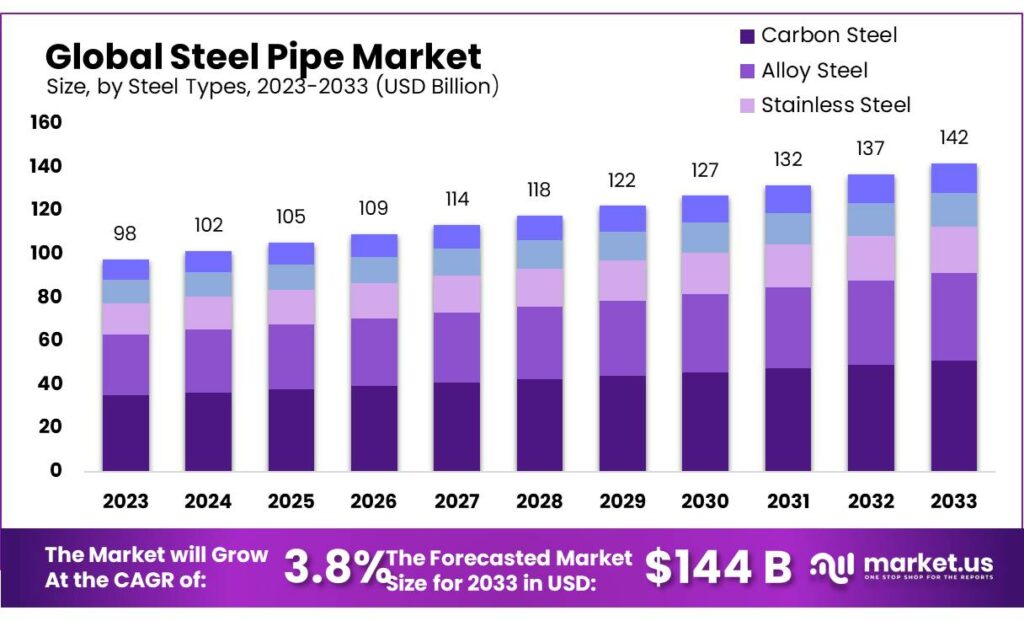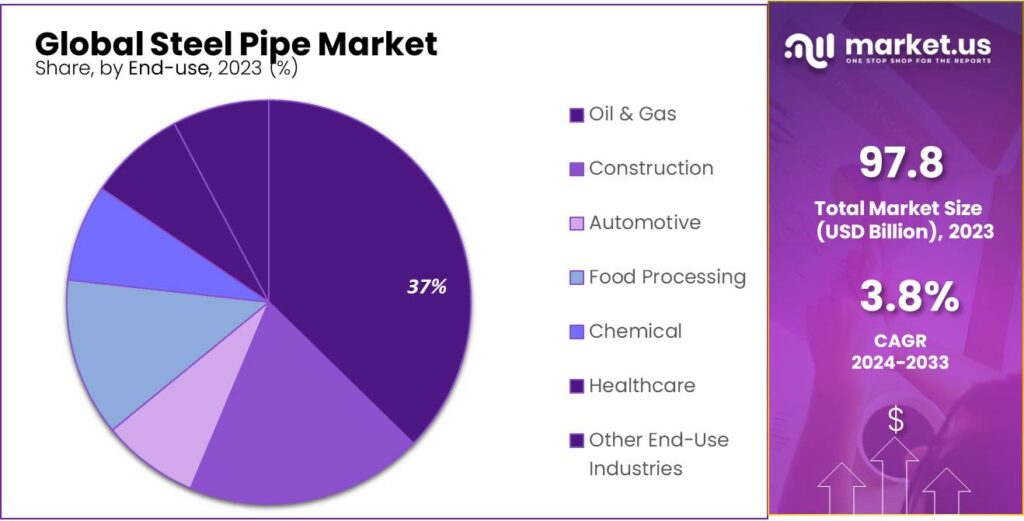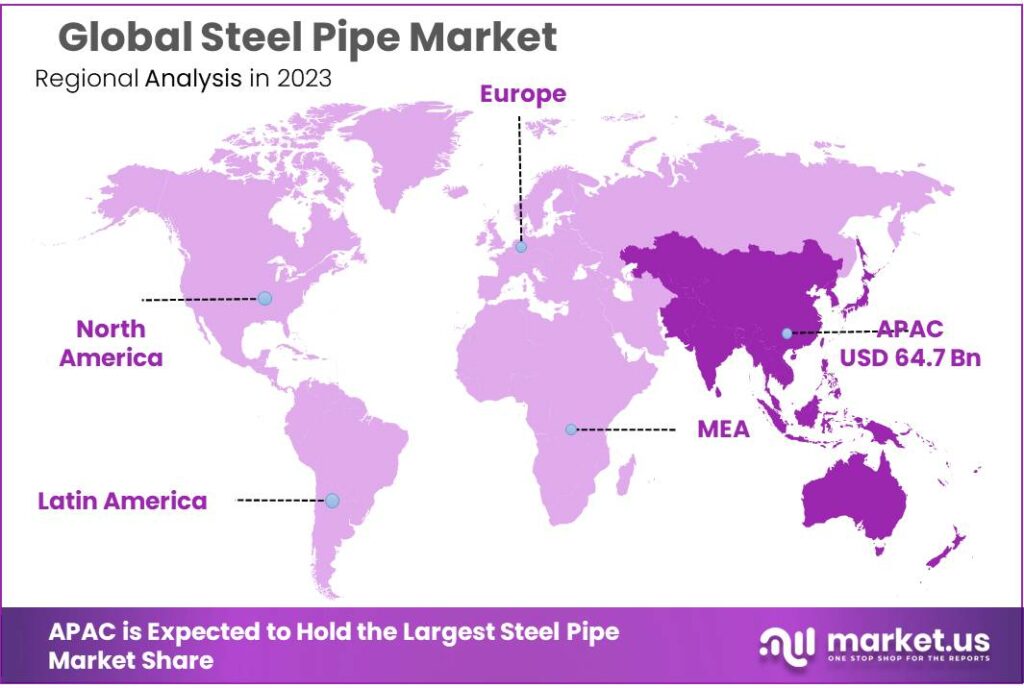Global Steel Pipe Market Based on Steel Types(Carbon Steel, Alloy Steel, Stainless Steel, Tool Steel, Other Steel Types), Based on End-Use Industries(Oil & Gas, Construction, Automotive, Food Processing, Chemical, Healthcare, Other End-Use Industries), By Region and Key Companies - Industry Segment Outlook, Market Assessment, Competition Scenario, Trends and Forecast 2024-2033
- Published date: Dec 2023
- Report ID: 30209
- Number of Pages: 239
- Format:
- keyboard_arrow_up
Quick Navigation
Market Overview
The Steel Pipe Market size is expected to be worth around USD 142 billion by 2033, from USD 97.8 Bn in 2023, growing at a CAGR of 3.8% during the forecast period from 2023 to 2033.
Steel pipes are cylinder-shaped steel tubes that are used in a variety of applications in the steel industry. Steel pipes are mostly used to transmit items such as oil, gas, and water over large distances.
Steel pipes are utilized in everyday equipment including refrigerators, heating systems, plumbing systems, etc. Infrastructural development is another important aspect of steel pipe application, i.e., for structure building requirements such as handrails and pipe bollards.
There are different types of steel pipes depending on their given application, such as those made from carbon steel, stainless steel, etc.

Note: Actual Numbers Might Vary In The Final Report
Key Takeaways
- Market Growth: The Steel Pipe Market is set to surge, reaching a projected worth of USD 142 billion by 2033, growing at a steady CAGR of 3.8% from USD 97.8 billion in 2023.
- Steel Pipe Applications: They serve various industries – from transporting oil, gas, and water across long distances to everyday uses in refrigerators, heating systems, plumbing, and infrastructure development like building structures and handrails.
- Steel Types and Their Dominance: Carbon Steel leads the market, constituting over 36%, followed by Alloy Steel and Stainless Steel. Each type caters to specific industry needs due to unique properties like strength, corrosion resistance, and durability.
- End-Use Industries: Oil & Gas holds a significant share (over 37%) due to reliance on steel pipes for transportation. Construction, automotive, food processing, chemical, healthcare, and other sectors also heavily rely on steel pipes for their operations.
- Market Drivers: Growth in industrial sectors like automotive, petrochemicals, and chemicals fuel demand. Steel pipes play a vital role in expanding the oil & gas sector while modernizing water management systems and automotive technology drive market growth.
- Market Restraints: Unpredictable raw material prices, competition from substitute materials like plastic pipes, and environmental concerns regarding steel production pose challenges. Economic uncertainties and geopolitical tensions affect market stability.
- Market Opportunities: Infrastructure development, renewable energy, water management, urbanization, and technological advancements present avenues for growth. Smart city initiatives and innovations in steel manufacturing offer significant opportunities.
- Regional Analysis: Asia Pacific holds the largest revenue share (over 61% in 2023) with a focus on emerging economies and government initiatives promoting domestic manufacturing.
- Key Players and Innovations: Major industry players like ArcelorMittal, Nippon Steel, Tata Steel, and others are driving innovation, focusing on low-carbon emission steel tubes and eco-friendly materials, showcasing the industry’s commitment to sustainability.
By Steel Types
In 2023, Carbon Steel was the top choice in the Steel Pipe Market, owning more than 36% of it. Carbon steel pipes are really strong and not too expensive, so lots of industries like using them. They’re big in construction, making roads, and buildings, and in making stuff like machines and equipment.
Their dominance in the market demonstrates their ubiquity across applications. Alloy Steel Pipes represent another important subsegment of the Steel Pipe market. Renowned for their enhanced strength and resistance to corrosion, alloy steel pipes are widely utilized by oil and gas, automotive, and aerospace industries – creating a more varied market as their unique properties meet specific requirements.
Stainless Steel pipes are another essential market segment. Praised for their corrosion resistance and durability, stainless steel piping has long been preferred in industries where hygiene and rust protection are crucial, including food processing plants, pharmaceutical facilities, and water distribution networks.
Their popularity within these sectors cements stainless steel’s place as part of this market segment. Tool Steel Pipes represent a distinct segment within the Steel Pipe Market. These pipes play an essential role in tool manufacturing and applications that demand high strength, durability, and resistance to wear and deformation – such as automotive manufacturing, machinery repair, toolmaking industries, etc. Their special properties make them invaluable assets in these sectors.
Other Steel Types encompass various steel compositions designed specifically to address specific applications. This may include specialty pipes tailored specifically for industries like construction, mining, and energy – contributing to market diversity while meeting niche demand.
Each steel type within the Steel Pipe market serves a distinct function across industries, contributing to overall market dynamics and meeting varying needs. Carbon Steel dominates, with alloy, Stainless, Tool, and Other Steel Types offering options tailored specifically towards specific applications or industries.
By End-Use Industries
In 2023, oil & gas was big in the steel pipe market, having over 37% of it. They need steel pipes to move oil and gas from place to place. Construction is also important. Steel pipes are used to make roads, bridges, and buildings strong.
Car and truck makers use steel pipes too. They help make vehicles tough and sturdy. Food processing is another important sector. Steel pipes are used in this industry to make equipment that handles food safely and cleanly.
Chemical and healthcare industries use steel pipes too. They’re used in chemical plants and hospitals for various purposes, ensuring safety and reliability in different applications. Other industries also rely on steel pipes for specific needs, contributing to their diverse usage across different sectors. While oil & gas takes a big chunk, steel pipes play a vital role in many other industries, showing their wide range of uses.

Note: Actual Numbers Might Vary In The Final Report
Market Segments
Based on Steel Types
- Carbon Steel
- Alloy Steel
- Stainless Steel
- Tool Steel
- Other Steel Types
Based on End-Use Industries
- Oil & Gas
- Construction
- Automotive
- Food Processing
- Chemical
- Healthcare
- Other End-Use Industries
Drivers
Industrial sector growth and development have an immense effect on the global steel pipes market. Steel pipes play an indispensable role in various industries like automotive, petrochemicals and chemicals manufacturing processes as channels for liquids, gases, and materials to move through production lines.
When selecting pipes for specific uses factors like diameter strength and pressure rating are all of equal importance. Steel pipes and tubes play an integral part in expanding the oil & gas sector, contributing significantly to market growth. Adjustments have led to significant revenue increases; reaching USD 332.9 billion in US markets by 2022 – an increase from USD 211.2 billion seen the prior year.
Modernizing water management systems has caused steel pipes to gain in popularity, as their corrosion resistance makes them ideal for managing industrial wastewater, potable water delivery, and sewage disposal. Their growing use in supply and treatment systems as well as increasing worries over water scarcity has furthered this growth of steel pipe infrastructure development projects.
Steel pipes play an integral part in automotive technology, serving as structural components, exhaust systems, and various parts. With the advent of electric vehicles and lightweight initiatives, the market anticipates growth opportunities as well as advanced solutions designed to meet ever-evolving automotive sector needs. This transformation in automotive technology should drive an increase in steel pipe demand over the coming years.
Restraints
Pipe manufacturing can be hindered by unpredictable raw material prices. Steel prices, an essential material in production processes, may fluctuate dramatically and alter market dynamics significantly, hurting production costs and altering profitability margins for manufacturers while shifting pricing strategies. Substitute materials present an additional obstacle.
Plastic pipes and other substitute materials compete with steel pipes in industries where lightweight or corrosion-resistant materials are preferred, creating competition within the market that threatens its growth. Their availability and promotion pose another significant threat.
Environmental concerns surrounding steel production also affect its market. Steel manufacturing requires significant energy use and emissions; compliance with stringent environmental regulations may present hurdles to its growth; demand for eco-friendly alternatives may further restrict sales in this area of industry.
Economic uncertainties and geopolitical tensions also affect the steel pipe market. Trade disputes, tariffs, and global economic instability can have serious ramifications on supply chains, demand, and investment decisions within an industry, creating significant unpredictability amongst stakeholders in an already unnerved industry.
Delays or cancellations of infrastructure projects due to funding concerns, regulatory complexities, or political uncertainties can hinder market expansion as demand for steel pipes decreases in construction and other sectors. Combatting these challenges requires innovation, cost-efficient production methods, and sustainability initiatives within the steel pipe industry. Overcoming these restraints will enable more resilient and adaptable markets for steel pipes.
Opportunities
Infrastructure development represents one of the greatest growth prospects for steel pipes worldwide. As investments surge into emerging economies’ infrastructure projects, demand for steel pipes to construct roads, bridges, and utilities increases dramatically – offering promising expansion prospects for this segment of the steel pipe market.
Renewable energy industries present great opportunity, with steel pipes playing an essential part in infrastructure such as wind turbines and solar panel mounting structures that use them. As we transition towards cleaner sources of energy production, steel pipe demand in this sector should increase significantly.
Water and wastewater treatment facilities also present growth opportunities, given rising concerns regarding water scarcity and an increase in demand for efficient management systems. With increased interest being shown towards using steel pipes as parts of supply, treatment, and distribution networks worldwide.
The oil & gas industry remains positive. Despite challenges associated with exploration and production activities as well as advances in drilling technology, ongoing exploration and production activities continue to rely on steel pipes for pipelines, well casings, and related infrastructure needs.
Urbanization and smart city initiatives around the globe present steel pipes with an enormous opportunity. Steel pipes serve a vital purpose in developing smart infrastructure – such as transportation systems, utilities, and communication networks. Technological advancements and product innovations within steel manufacturing provide ample opportunity for market expansion. By designing high-performing, corrosion-resistant, and sustainable pipe solutions you can gain an edge in competition while expanding the market.
The Steel Pipe Market provides numerous opportunities across multiple sectors – infrastructure, renewable energy, water management, oil & gas exploration, and urban development are just a few examples – that could drive significant growth and innovation within this industry. By seizing upon them and capitalizing on them you could experience exponential expansion and innovation within this space.
Challenges
Manufacturers currently face one major difficulty due to fluctuating raw material costs, particularly steel prices which is the primary material used in pipe production. Steel can disrupt production expenses and alter pricing strategies in the marketplace place resulting in diminished profit margins for companies while changing pricing strategies used at that particular moment in time.
Another challenge related to alternative materials is competition from substitute materials. Substitute plastic pipes or composite materials pose a threat, especially for industries relying on corrosion-resistant or lightweight materials for corrosion protection or lightweight operations. Furthermore, their promotion represents another hurdle in market expansion.
Environmental concerns surrounding steel production also impact the market landscape. Steel manufacturing involves extensive energy consumption and emissions, prompting environmental concerns. Adherence to stringent environmental regulations adds further complications and restrictions to market operations.
Geopolitical tensions and economic uncertainties also present challenges. Trade disputes, tariffs, and global economic instability can alter supply chains, market demands, and investment decisions, creating uncertainty for all involved within an industry.
Reluctant infrastructure development in certain regions can hamper market expansion. Delays or cancellations due to funding limitations, regulatory complexities, or political uncertainties could significantly decrease demand for steel pipes used in construction and other related sectors.
Responding to these challenges requires innovative, cost-effective production methods and sustainable practices within the steel pipe industry. Overcoming these hurdles can help create a more resilient and adaptable market environment for steel pipes.
Regional Analysis
Asia Pacific (APAC) had the largest revenue share at over 61% in 2023. It is expected that the recovery of the North American economy and the growth of many important end-use businesses will remain key driving factors for steel production.
The Asia Pacific was the top regional market in 2023, accounting for more than 55%. India is expected to benefit from government initiatives to promote domestic manufacturing. These initiatives will reduce dependence on imports and increase regional production.

Note: Actual Numbers Might Vary In The Final Report
Key Regions and Countries
North America
- US
- Canada
- Mexico
Europe
- Germany
- UK
- France
- Italy
- Russia
- Spain
- Rest of Europe
APAC
- China
- Japan
- Korea
- India
- Rest of Asia-Pacific
South America
- Brazil
- Argentina
- Rest of South America
MEA
- GCC
- South Africa
- Israel
- Rest of MEA
Key Players Analysis
The steel pipe market comprises several key players contributing significantly to the industry’s growth, innovation, and market presence. Here are some of the major players in the global steel pipe market:
Key players
- ArcelorMittal S.A.
- United Steel Corporation
- Nippon Steel Corporation
- Tata Steel
- Rama Steel Tubes Limited
- Steel Authority of India Limited
- Jindal Steel & Power Ltd.
- Hyundai Steel
- ThyssenKrupp AG
Recent Developments
In July 2023, ArcelorMittal unveiled the industry’s first low-carbon emission steel tubes with a CO2 emission reduction of up to 75%, designed to assist companies across construction, agriculture and energy in meeting climate goals outlined in both the Paris Agreement and the European Green Deal.
In June 2022, Nippon Steel Corporation developed and started providing Snow Peak, inc. (“snow peak”) with Eco-Friendly Commercially Pure Titanium known as Trantixxii-eco, to help reduce CO2 emissions while conserving resources with titanium ingots made up of over 50% scrap titanium content allowing homogenization ingot components for higher quality products despite high scrap content in their ingot.
Report Scope
Report Features Description Market Value (2023) USD 97.8 Bn Forecast Revenue (2033) USD 142 Bn CAGR (2023-2032) 3.8% Base Year for Estimation 2023 Historic Period 2018-2022 Forecast Period 2024-2033 Report Coverage Revenue Forecast, Market Dynamics, COVID-19 Impact, Competitive Landscape, Recent Developments Segments Covered Based on Steel Types(Carbon Steel, Alloy Steel, Stainless Steel, Tool Steel, Other Steel Types), Based on End-Use Industries(Oil & Gas, Construction, Automotive, Food Processing, Chemical, Healthcare, Other End-Use Industries) Regional Analysis North America – The US & Canada; Europe – Germany, France, The UK, Spain, Italy, Russia & CIS, Rest of Europe; APAC- China, Japan, South Korea, India, ASEAN & Rest of APAC; Latin America- Brazil, Mexico & Rest of Latin America; Middle East & Africa- GCC, South Africa, & Rest of MEA Competitive Landscape ArcelorMittal S.A., United Steel Corporation, Nippon Steel Corporation, Tata Steel, Rama Steel Tubes Limited, Steel Authority of India Limited, Jindal Steel & Power Ltd., Hyundai Steel, ThyssenKrupp AG Customization Scope Customization for segments, region/country-level will be provided. Moreover, additional customization can be done based on the requirements. Purchase Options We have three licenses to opt for: Single User License, Multi-User License (Up to 5 Users), Corporate Use License (Unlimited User and Printable PDF) Frequently Asked Questions (FAQ)
What Are Steel Pipes?Steel pipes are hollow tubes made of steel, primarily used for the transportation of fluids and gases in various industries. They come in different sizes and thicknesses and are known for their strength, durability, and resistance to corrosion.
What Are the Key Applications of Steel Pipes?- Oil and Gas: Used for transporting oil, natural gas, and petroleum products.
- Construction: Utilized in structural frameworks, building foundations, and plumbing systems.
- Water Transmission: Essential for water supply networks, irrigation systems, and drainage.
- Automotive and Aerospace: Used in the manufacturing of vehicles and aircraft.
- Industrial and Mechanical Applications: Used in machinery, equipment, and manufacturing processes.
How Does Environmental Awareness Impact the Steel Pipe Market?Environmental concerns are pushing for the use of more sustainable materials and production methods. This trend encourages the development of steel pipes with improved recyclability and reduced environmental impact.

- ArcelorMittal S.A.
- Steel Authority of India (SAIL)
- Tata Iron and Steel Ltd.
- Jindal Vijaynagar Steel (JVSL)
- Essar Steel and Ispat Industries
- American Cast Iron Pipe Company
- Baosteel Group Corporation
- Evraz Plcevraz Plc
- Anhui Tianda Oil Pipe Company Limited
- Hyundai Steel Company
- and JFE Holdings Corporation
- among others.
- settingsSettings
Our Clients
| Single User $4,599 $3,499 USD / per unit save 24% | Multi User $5,999 $4,299 USD / per unit save 28% | Corporate User $7,299 $4,999 USD / per unit save 32% | |
|---|---|---|---|
| e-Access | |||
| Report Library Access | |||
| Data Set (Excel) | |||
| Company Profile Library Access | |||
| Interactive Dashboard | |||
| Free Custumization | No | up to 10 hrs work | up to 30 hrs work |
| Accessibility | 1 User | 2-5 User | Unlimited |
| Analyst Support | up to 20 hrs | up to 40 hrs | up to 50 hrs |
| Benefit | Up to 20% off on next purchase | Up to 25% off on next purchase | Up to 30% off on next purchase |
| Buy Now ($ 3,499) | Buy Now ($ 4,299) | Buy Now ($ 4,999) |












